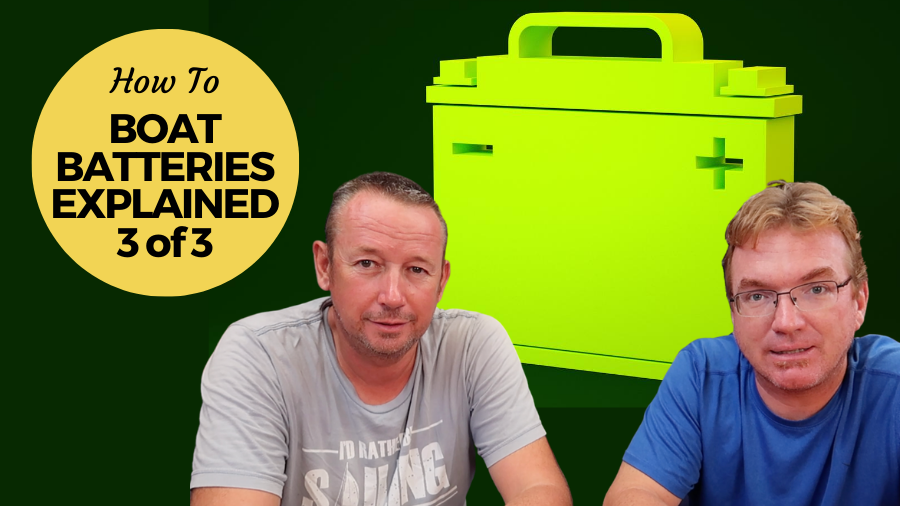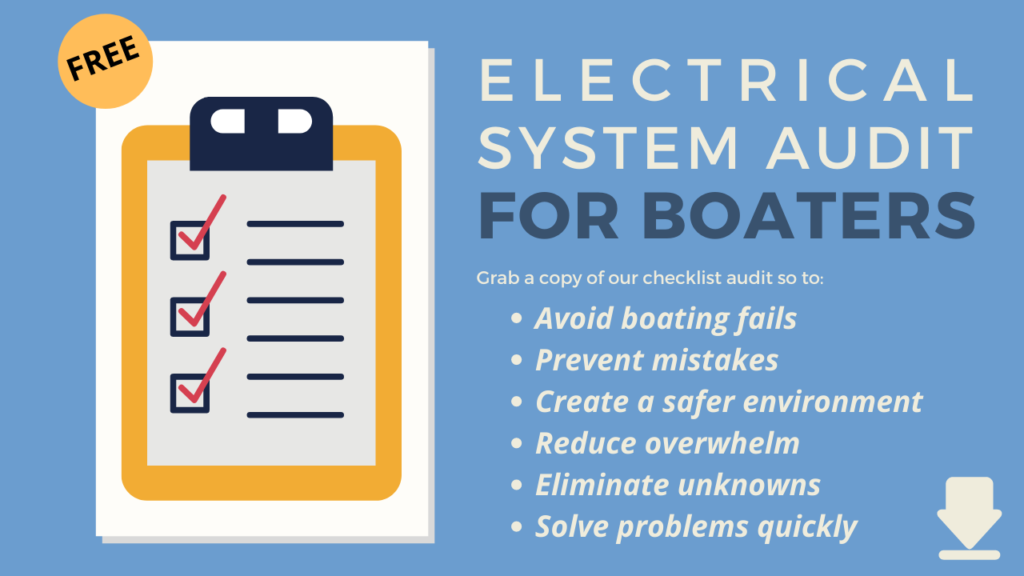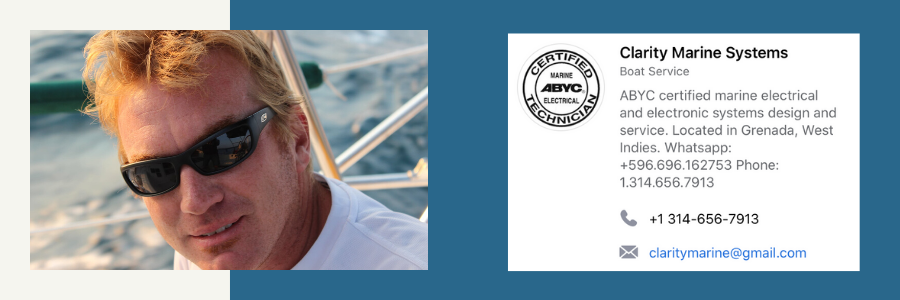Are you interested in how to increase the lifespan of your batteries? If you’re a boater, you should be.
Replacing your boat batteries is also a huge cost, to the tune of thousands of dollars, depending on what type of batteries you decide to purchase.
Though the performance of your batteries will naturally and normally depreciate over time, there are ways to extend their lifespan and push that big invoice farther down the road. This article and video are about how to increase the lifespan of your batteries.
This is the final part of our 3-part series on The Beginner’s Guide to Marine Boat Batteries. Review Part 1 here Marine Boat Batteries, on understanding what type of batteries you have on board, and how to maintain them. Part 2, How to Manage Your Boat Battery Bank, covers learning the normal levels for your bank and identifying the right charging strategy for your particular system.
Watch the video and then carry on reading below for more in-depth information.
How To Increase The Lifespan of Your Batteries Video
Check your batteries regularly.
Every few months, visually check the condition of your batteries. Are there any beginning signs of corrosion? Any connections that may have loosened up? Check the tension of all of your bolts. This is even more important if you’re out at sea frequently and/or found yourself in rough seas. If you have lead-acid batteries, these regular checks are also an opportunity to verify if any electrolyte has spilled. You can also check your water levels.
The more often you look, the sooner you’ll catch a problem.
Fully charge your batteries regularly, and minimize how far you discharge them.
Lead acids – AGM, gel, or flooded – need to be fully charged regularly, though LiFePo4’s do not. One of the leading causes of premature lead-acid battery failure is consistent undercharging. Once a week at the least, bring your batteries to 100% state of charge. The charging mechanism you use (shore, generator, solar) needs to reach float. When this happens, your amp-hour counter on your battery monitor should get up to zero and then head into positive territory – effectively calibrating itself.
Many boat owners only charge their batteries to 60-70%. As discussed in the previous video in this series, this is likely due to an inadequate charging strategy. The owners then bring them down to 50% and then charge them back up to 70%. If the lead-acid batteries stay in this cycle, it significantly reduces their lifespan. This is a key point on how to increase the lifespan of your batteries.
Aim to stop discharging no further than 50% to really maximize the lifespan of your batteries.
So how do you know? Here are the ballpark levels for lead-acid batteries:
12.2 – 12.25 volts – 50% charged
12.4 – 12.45 volts – 75% charged
12.65 – 12.75 volts – 100% charged
Avoid sulfation by equalizing your battery bank.
When lead-acid batteries discharge to power your boat, a soft material called lead sulfate forms on the internal plates. When the battery is charged, this material is reconverted off of the plates and goes back into solution. This cycle is the natural operation of the internal components of the battery.
However, if you’re not fully charging your batteries, or you’re discharging too much, this normally soft material can begin to crystalize. At this point, when you start charging again, the material can’t easily reconvert, and that’s when you start losing battery capacity.
If you have wet lead-acid batteries, one thing you can do is equalize your bank every three or four months. (This is not a solution for maintenance-free lead-acid batteries, as you’ll need to actively assess the water levels of the batteries during and after the process.) The equalization process helps to reconvert crystalized sulfation back into solution.
Equalizing your batteries on a regular basis will significantly increase the lifespan of your wet batteries, but you can only do so if you have a charger that has this capability. Read the manual and follow the directions – they are usually clearly detailed. Make sure you equalize your batteries when your boat is well ventilated and be sure to top up your water levels after equalizing, as the batteries will naturally vent.
How to increase the lifespan of your batteries? Be aware that loss in battery capacity is not sudden.
Throughout the normal use of a boat battery bank, the decline in capacity happens slowly over time – usually over a handful of years. How slowly depends on how well the batteries are maintained and the loads put on them regularly.
If you see a sudden significant change in the battery levels, there’s a problem beyond the normal deterioration of their lifespan. This could be due to a number of reasons.
As discussed in How To Manage Your Boat Battery Bank, one of the batteries could be failing, bringing the entire bank down. Often when this happens, one battery (or a pair of 24v) could feel warmer to the touch than the others. This is an indicator that something’s amiss. Disconnect your bank and check your levels at each battery. Ten minutes after disconnecting them, the bad battery will often fall down in voltage much more than the others.
Reasons for this? The internals of the batteries may have broken down over time, which can cause thermal runaway.
This means that the internal components of the batteries have degraded to the point that they are short-circuiting internally. The remaining charge will start rapidly discharging, creating heat, and off-gassing. The fumes can be deadly if in a confined space, and the battery may start bulging in shape.
If thermal runaway is occurring, shut down your DC system (battery switch) and open up the boat as quickly and as much as possible to dispel the fumes. Disconnect the battery from the bank to protect the others, and if you can, remove the bad battery from the boat. After a few hours, the heat and off-gassing should subside, and the battery can be properly disposed of.
You can then rewire your bank around your remaining batteries. You’ll still have a house bank – it will just have a smaller capacity.
Also, keep in mind that a sudden decrease in battery levels may have nothing to do with the batteries themselves. Another system on your boat – perhaps your fridge or freezer – may have gone on the fritz, significantly increasing the load on your batteries. Or you could have reached a tipping point of corrosion somewhere in the wiring. Once you find the problem and fix it, your battery performance should return to your normal levels.
Keep the same generation of batteries in your bank.
If you do remove a battery from your bank due to failure, you may be keen to simply buy another battery to replace it and add it to your existing bank. This is not recommended when considering how to increase the lifespan of your batteries.
Generally speaking, you want all of the batteries in your bank to be the same type, the same size, and the same age. If you drop in a new battery with batteries that are four years old and are operating at a decreased capacity, for instance, the older batteries will pull down the new battery, and will significantly decrease the new battery’s lifespan.
FREE TOOL: GET YOUR ELECTRICAL SYSTEM AUDIT CHECKLIST
For a limited time, we’re offering a checklist to help you know what you need to know about your boat’s electrical systems, the basics of troubleshooting, and how to determine when it’s time to call in an expert. Get the Electrical System Audit here.
Are you in or going to Grenada?
Make sure to contact Aaron if you’re in Grenada.
Owner Aaron Downey grew up powerboating and began racing sailboats in the U.S. in 2000. He and his wife purchased their first cruising sailboat in 2012. After completing his USCG Master’s license in 2012 and ABYC exams in 2013, Aaron founded CMS as a side business at the repeated requests of fellow boat owners and yacht yards.
His many years designing large, complex land-based technology and electrical systems paired nicely with his experience on the water, creating a unique and robust skillset.
Since then, CMS has seen a long list of happy boat owners in its wake, throughout the U.S. and Caribbean. Let us assist you with your system design or problem-solving – no matter how big or small, simple or complex. From small sailboats to superyachts, simple circuits to large yacht refits, CMS has been there. Click the image below for more information on Aaron from Clarity Marine Systems.
Other articles of interest
- The Beginners Guide To Marine Boat Batteries (Part 1 of this 3 part series)
- How To Manage Your Boat Battery Bank (Part 2 of this 3 part series)
- Our Solar Power Installation
- Lithium Battery Upgrade
- Understanding Your Boat’s Electrical Systems
- How To Prevent Boat Fails
Any questions or comments about how to increase the lifespan of your batteries?
Please leave them below.
Credits
The articles in this series are guest-written by Meg Downey.



Nostalgia…the Genesee beer t shirt. I certainly miss my favorite…”green pop”…Genesee Cream Ale. Lol
Thanks for the well developed Battery series. Simple and articulate.